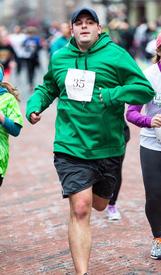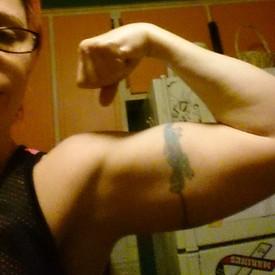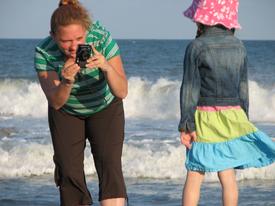RUNNERS what stretches do I need to do to avoid shin splints

ojell
Posts: 748 Member
Ok guys, here's the deal. I've never been a runner like EVER. LOL But I did try it out over the summer...I think I was actually starting to like it. I was so proud of myself. I had a nice little routine going and everything. BUT THEN...I got shin splints! They hurt so bad and halted my working out all together because I couldn't really do anything without them hurting. Well, I confess I've been afraid to get back into running ever since. I am sooo afraid I'm gonna get them again...not only because they do hurt but because I'm finally doing ok with this whole weight-loss/fitness thing and I don't want shin splints to stop all of my progression.
Sooo...I've been thinking about either doing the routine I did before OR starting C25K.
My obvious concern is shin splints but also the possibility of other injuries.
Help me out...please? How can I ensure that I do not get shin splints again. I think I would really enjoy being a runner.
Sooo...I've been thinking about either doing the routine I did before OR starting C25K.
My obvious concern is shin splints but also the possibility of other injuries.
Help me out...please? How can I ensure that I do not get shin splints again. I think I would really enjoy being a runner.
0
Replies
-
The best thing you can do to prevent shin splints is to get a gait analysis done at a running store and buy the appropriate shoes.0
-
Proper shoes (running shoe store) and form are key.
I use to get shins splints all the time in high school track and my husband taught me how to run and the pain disappeared and I no longer needed ice baths.
I found this image and here is a description from a men's journal magazine @ http://www.posetech.com/library/pp-MJ-0001.html:
Proper form: keeping your center of gravity over the balls of your feet, landing on your mid- or forefoot rather than on your heel, and taking shorter, more fluid strides.
Here is the worst way to run - heel striking! http://www.posetech.com/training/archives/000564.html0 -
proper shoes and recovery calf sleeves are amazing0
-
Walking for 5-10 minutes prior to running and then stretching my calves is what stopped my shin splints. Mine got so bad that my shins were visably bruised and lumpy. also alternating moist heat with ice packs to help them heal. If they get really bad, you will have to rest, don't push through the pain or you can get stress fractures in the bone. keep training and don't push too hard, it will get better.0
-
Shin splints are terrible!
Stretching before you run is important - stretch the back of your calf and the front of your leg, and also remember to stretch after you run too!
Agree about the shoes - I was getting really bad shin splints and it turned out that I had the wrong shoe fitted, once I fixed that they were pretty much gone!
Also, treating shin splints properly is key so as not to screw up your workout plans - elevation with ice (although not very fun) really works well!
Good luck - I never used to be a runner, but now I'm addicted :-)0 -
You have to go to the source of the problem and get yourself a pair of appropriate shoes. Go to a Running Room (if you are in Canada or select States) in your area and get REAL running shoes (not cross trainers)... They find out exactly what is the issue with your feet and help you to find what kind of shoe works for you...something with motion control, cushioning and/or stability.
I am sure if you googled you can find tips on picking the right running shoe as well. However, don't buy online because you really need to try them on first.0 -
You may get them again, its part of running. But you shouldn't have them to the extream you seemed to have last time. Here are some things you can do to reduce your risk of injury and shin splints.
1) Don't run every day right off the bat. Take "rest" days. Do the bike or elliptical or something on your off days. Cross training is good too. I started with running one day and doing something else the next for a few weeks. Then you can start to run two days and take a rest, etc. This lets your body adapt. If you are feeling pain, take a rest day.
2) Get a good pair of running shoes. Go to the running shoe store and let them watch you run and pick out the best shoes for how you run.
3) Avoid heel strikes (when you are running and your heel hits the ground), you should aim for a mid-foot strike. You may need to shorten your stride to but it is more important to run correctly than fast.
4) Stretch your calf and achelies. This is a video with one proper stretching technique. http://www.youtube.com/watch?v=xI0tT0dY95E
http://www.youtube.com/watch?v=xI0tT0dY95E
5) Eat nutrient rich foods. Your body will rebuild itself as you tear it down with running. Having good wholesome sources of protein, vitamins, and minerals are essential to a quick recovery. The longer it takes you to recover the longer before you can run again.
I hope that helps!0 -
I read that shin splints are from "too much too soon". Maybe try slowing down your pace or distance. And gradually build back up.
Also I read about filling those little dixie cups up with water, then freezing them. After a run, peel the cup off the ice or just roll the whole thing as is over your shins.
What worked for me the most was doing interval runs.0 -
Form and Shoes are important but there are some basic stretches that will/can prevent shin splints, I ran track all through high school and college and constantly battled shin splints.
walking on your heels for 40 meters a few times , then on your toes a few times added into your stretching routine
sit in a pike position ( legs extended straight in front of you ) and have someone pull your toes away from your, this is excellent and you should feel the stretch right away , hold for 15sec and repeat 3x
another thing to keep in mind is that your calf and achiles tendon being loose with also help with shin pain
another general stregnthing routine is write the alphabet in the air with your toes while sitting in the office or wherever, the pivoting and changing angles of your foot/ankle with increase the the stabilizer muscles
hope this helps! good luck0 -
I agree with the above posters about wearing a good shoe that fits well. When I started my marathon training I was getting shin splints. I went to a running store for a fitting, and it turns out I should have been wearing wider shoes. Everything was fine after that.0
-
The best thing you can do to prevent shin splints is to get a gait analysis done at a running store and buy the appropriate shoes.
This^^^^ and, after I got the right shoes, they told me to ice down my shins for 15 to 20 mins after each run. It really helped out a lot. But it is most likely the shoes that are the problem (not right for your gait). I overpronate and have low arches...never knew that before being tested. I got the right shoes and now when I "kill" the shoes and run all the miles I can in them, I literally know it within 1/10 of a mile.0 -
My boot camp instructor has us do what she calls Ankle Beths to help prevent shin splints. You basically point your toes and write out the alphabet with your toes. You could see if that would help maybe.0
-
I actually have this same issue. I went about 2 wks ago to get fitted for shoes. They did the analysis and fitted me in good shoes. They have helped alot with the splints, but I still have them alittle. I asked the guy fitting me the same question. He said that if you do to much to soon it can cause them but also stated that alot of new runners, new being ones that haven't been running for a year or more, will get them no matter what they do to avoid. He stated that at least 50% of new runners will get them.. and there are things to help such as new good shoes, shin sleeves, and he said if they are really bad to freeze water in a bottle and roll it up and down your shins to break up the tissue. But he stated that over time and the longer you run over time they will go away. Like I said the new shoes have made a huge difference... but other than that I just massage them out every other day when I run! Hope this helps!0
-
proper shoes and recovery calf sleeves are amazing
I suffer from shin splints also. Get your running stride checked out from a place like Fleet Feet and buy the right shoes. Don't do too much too soon, you shouldn't add more than 10% of the distance you are running from week to week. And I recently purchased calf sleeves and they are amazing. I have a neoprene type that I where for running and a sock type (not as tight) that i wear for recovery. Also avoid concrete. Run on a softer surface or at least blacktop.
I ran a 5K last year and then had several injuries. I got Physical Therapy and learned a great deal... I am once again running and will soon be ready for another 5K.
Good luck... I know how you feel.0 -
Better shoes, as everyone already said, but ALSO lacing my shoes differently made a huge different. There are lots of lacing guides on the internet
 0
0 -
Here is a website with some really great information, especially if your just starting out!!
http://www.runnersworld.com/0 -
The most common reasons for beginner runners is they don't have proper running shoes,or increase their mileage too soon. Try to avoid concrete or sidewalks when you start out running.. I found dirt roads and running paths to be the best.
The best exercises are non impact such as swimming, pool running and cycling in low gear.
Build miles slowly, change shoes regularly and stretch your calves because tight muscles make the muscle in front o your leg work harder.
NEVER stretch before a run..start off in a jog to warm up and pick up speed as you loosen up.
After the run walk a few mins before stopping and then stretches. Hamstrings, quads and calves
You stretch afterwards because it flushes the muscles with blood and oxygen which promotes recovery....Happy running!!0 -
Calf stretches, hamstring stretches, ankle lifts, rest and ICE! Also getting proper foot wear.
I just got done with 3 months of non-stop pain in my right shin, rest, lots of ice, physical therapy and then ended up in a boot for 3 weeks, but finally it seems to be better.
I have very tight calves and a tight achilles which puts alot of stress on the shin.
I stretch before, after and ice, but the key is icing and rest when you are in pain, don't push because it will only continue to hurt and also you could get a stress frature. I also wear compression socks (soccer socks), they really seem to help and they aren't expensive at all. I have also changed up my exercises, I've added biking and treadmill (I also walked/ran outside on the hard pavement).0 -
Let me preface by saying I've run 4 marathons and will begin training for a fifth in the spring.
Your comfy shoes are allowing you to over stride and land on your heals. Take smaller quicker steps and try and relax. It seems counter productive, but the with smaller steps it is much easier on your entire lower body and with practice more efficient. Look up evolution running or pose, both are extremely good at teaching you proper form and I believe even offer DVD instruction. Good Luck!0 -
Bump!
some great advice here. 0
0 -
Ashimon and others gave lots of great suggestions here... I wanted to add - as a former sufferer of shin splints, AWFUL!! - that running barefoot is what allowed me to really enjoy injury free running. If nothing else, you quickly learn the proper gait and footstrike. Now that those have become more habitual for me, I can sometimes run in shoes without shin splints. Not everyone is going to actually prefer barefoot running like I do... but I think that for many people, doing at least *some* running barefoot can be really informative about how to run well. It was the answer to my "I want to run but it HURTS" problem.

Rest and ice until the pain is gone (otherwise you're just going to keep irritating them, and extend your injured time.) You want to make sure to stretch your calves and Achilles tendons well, and strengthen the muscles along your shin. Toe taps, lifting a weighted bag with your toes, writing the alphabet in the air with pointed toes, etc, all work that area.
When you start running again, slow and easy does it! The enthusiasm that makes you want to do all you can do all at once is what's going to cause injuries like shin splints... too much, too soon, is a recipe for getting laid up so you're not able to do anything for weeks. (BTDT -- it's really, really common!)0 -
Let me preface by saying I've run 4 marathons and will begin training for a fifth in the spring.
Your comfy shoes are allowing you to over stride and land on your heals. Take smaller quicker steps and try and relax. It seems counter productive, but the with smaller steps it is much easier on your entire lower body and with practice more efficient. Look up evolution running or pose, both are extremely good at teaching you proper form and I believe even offer DVD instruction. Good Luck!
^This.
Basically, you're using your heals too much causing strain on your shins. We are so used to having a nice cushion at the heals of our shoes (NIKE to blame), that we tend to use it as a crutch for comfort when in reality you're doing damage. The proper shoes can help however the proper strides are truly what you need to practice. Should be landing on the balls of your feet. A popular shoe these days are the 5 finger Vibram shoes. However they do take some time to break yourself into them.0
This discussion has been closed.
Categories
- All Categories
- 1.4M Health, Wellness and Goals
- 398.1K Introduce Yourself
- 44.7K Getting Started
- 261K Health and Weight Loss
- 176.4K Food and Nutrition
- 47.7K Recipes
- 233K Fitness and Exercise
- 462 Sleep, Mindfulness and Overall Wellness
- 6.5K Goal: Maintaining Weight
- 8.7K Goal: Gaining Weight and Body Building
- 153.5K Motivation and Support
- 8.4K Challenges
- 1.4K Debate Club
- 96.5K Chit-Chat
- 2.6K Fun and Games
- 4.8K MyFitnessPal Information
- 18 News and Announcements
- 21 MyFitnessPal Academy
- 1.5K Feature Suggestions and Ideas
- 3.2K MyFitnessPal Tech Support Questions
















